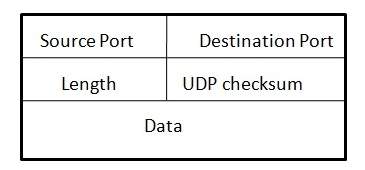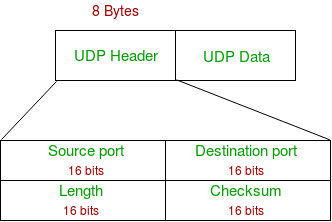User Datagram Protocol (UDP)
UDP is connectionless and unreliable protocol. It doesn’t require making a connection with the host to exchange data. Since UDP is unreliable protocol, there is no mechanism for ensuring that data sent is received.
UDP transmits the data in form of a datagram. The UDP datagram consists of five parts as shown in the following diagram:

Points to remember:
- UDP is used by the application that typically transmit small amount of data at one time.
- UDP provides protocol port used i.e. UDP message contains both source and destination port number, that makes it possible for UDP software at the destination to deliver the message to correct application program.

Applications of UDP
- Used for simple request response communication when size of data is less and hence there is lesser concern about flow and error control.
- It is suitable protocol for multicasting as UDP supports packet switching.
- UDP is used for some routing update protocols like RIP(Routing Information Protocol).
- Normally used for real time applications which can not tolerate uneven delays between sections of a received message.
- Following implementations uses UDP as a transport layer protocol:
- NTP (Network Time Protocol)
- DNS (Domain Name Service)
- BOOTP, DHCP.
- NNP (Network News Protocol)
- Quote of the day protocol
- TFTP, RTSP, RIP, OSPF.
- Application layer can do some of the tasks through UDP-
- Trace Route
- Record Route
- Time stamp
- UDP takes datagram from Network Layer, attach its header and send it to the user. So, it works fast.
- Actually UDP is null protocol if you remove checksum field.
